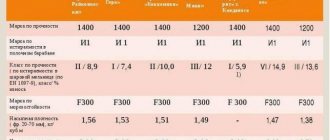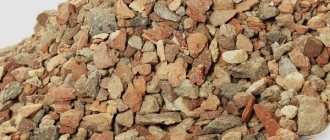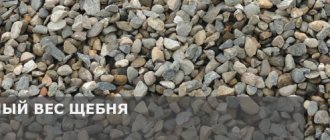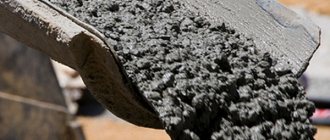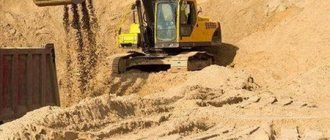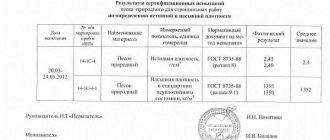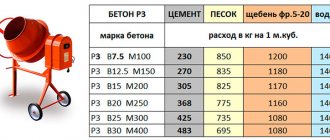When choosing building materials, it is very important to avoid both extremes - large balances in warehouses and, naturally, shortages of material at the most crucial moment. At the same time, very often the calculation of the required quantity can be very approximate, based on average data.
So, for example, knowing how much crushed stone in a cube of concrete is needed for its production, you need to order a certain number of tons of this material. But crushed stone is sold in cubic meters and you are faced with the task of determining how many tons of crushed stone are in 1 m3 of purchased material.
A rough estimate can be made based on the tables. Table 1 shows the bulk density of granite crushed stone of various fractions.
Table 1
| Crushed stone fraction | Brand | Weight |
| Granite crushed stone fraction 5-10 | M700 - M800 | 1.41 t/m3 or 1410 kg/m3 |
| Granite crushed stone fraction 5-20 | M700 - M800 | 1.39 t/m3 or 1390 kg/m3 |
| Granite crushed stone fraction 20-40 | M700 - M800 | 1.37 t/m3 or 1370 kg/m3 |
| Granite crushed stone fraction 25-60 | M700 - M800 | 1.36 t/m3 or 1360 kg/m3 |
| Granite crushed stone fraction 40-70 | M700 - M800 | 1.34 t/m3 or 1340 kg/m3 |
| Granite crushed stone fraction 5-10 | M1200 | 1.43 t/m3 or 1430 kg/m3 |
| Granite crushed stone fraction 5-20 | M1200 | 1.40 t/m3 or 1400 kg/m3 |
| Granite crushed stone fraction 20-40 | M1200 | 1.38 t/m3 or 1380 kg/m3 |
| Granite crushed stone fraction 25-60 | M1200 | 1.37 t/m3 or 1370 kg/m3 |
| Granite crushed stone fraction 40 70 | M1200 | 1.35 t/m3 or 1350 kg/m3 |
Table 2 shows the density of limestone crushed stone of various fractions.
table 2
| Crushed stone fraction | Brand | Weight |
| Limestone crushed stone fraction 10-20 | M600 | 1.41 t/m3 or 1410 kg/m3 |
| Limestone crushed stone fraction 20-40 | M800 | 1.31 t/m3 or 1310 kg/m3 |
| Limestone crushed stone fraction 40-70 | M600 | 1.26 t/m3 or 1260 kg/m3 |
These are averaged data, but the weight of 1 m3 of crushed stone can be more accurately determined taking into account its properties.
Conversion of crushed stone from a cube (1 m3) to tons
| 1 cube of crushed stone | Tons |
| crushed limestone | 1,3 |
| crushed limestone 5-20 | 1,37 |
| crushed limestone 20-40 | 1,41 |
| crushed limestone 40-70 | 1,47 |
| granite crushed stone | 1,39 |
| granite crushed stone 5-20 | 1,35 |
| granite crushed stone 20-40 | 1,38 |
| granite crushed stone 40-70 | 1,44 |
| crushed gravel | 1,35 |
| crushed gravel 5-20 | 1,43 |
| crushed gravel 20-40 | 1,54 |
| crushed gravel 40-70 | 1,65 |
What affects the bulk density of crushed stone?
Crushed stone can have fractions of completely different shapes and sizes. And while the volume is being filled, such indicators are considered the main ones. Some properties stand out:
Flakiness is the most important factor that cannot be ignored. To determine the amount of tone in one cube, you need to know what shape the crushed stone is. It is also necessary to take into account acicularity and plasticity . After all, the filling of the cube most of all depends on how many “plates” and “needles” there are in the rock.
For example, cube-shaped crushed stones have a fairly high degree of compaction . But in rocks that have needles and plates, the density is much lower due to the presence of voids in considerable quantities. So it is better not to use it as a concrete compactor during construction. Because this threatens with a large consumption of most building materials. So for dense filling, crushed stone with low flakiness (no more than 15%) is preferably used. But when it is necessary to make a backfill or “pillow”, then use normal rock with many voids. And the flakiness index of such crushed stone should be about 25-50%.
Water absorption is also a very important parameter when determining the number of tons in one cube of crushed stone. If this factor is not taken into account during recalculation, then the probability of a high error is quite high. The main factors that influence water absorption :
- Different porosity of rocks.
- Various fraction sizes. After all, smaller fractions have a larger total area, and accordingly their surface retains water better. For different materials, water absorption can reach 10%. If this fact is not taken into account, the measurements will be erroneous.
Once you have determined how many tones are in one cube, you should not order exactly as many as you counted. Since water absorption alone can take up to 10% of its total mass, and it’s not even worth talking about flakiness and fraction. So when purchasing, you should make a reserve of 10 percent, preferably 20. And it is better to order crushed stone not all at once, but in parts. So that at the end of the work you do not end up with a lot of waste .
Features of calculations and necessary parameters
You can determine the approximate mass of 1 cubic meter of crushed stone based on the approximate bulk density. It can be found out by knowing the origin of the material and the size of its particles (fineness modulus). Such parameters are indicated in the accompanying documentation (certificates, passports, declarations), which the seller is obliged to provide at the client’s request. But approximate data can be found from regulatory documents, such as GOST 8269.0-97 “Crushed stone and gravel from dense rocks.”
The document describes in detail the methods of physical and mechanical testing, including methods for determining voidness and bulk density - the ratio of mass to volume, taking into account the free space between particles. Standard indicators are given in the table.
Methods for converting the volume of crushed stone into mass
If all the data is available, then you need to multiply the density by the fullness. For example, granite has a density of 2600 kg/m3, and its voids are 5−20 mm. That is, emptiness is 43%, and fullness is 57%. Based on these data (2600 x o, 57) there are 1483 kg of crushed stone in one cubic meter. But for lime material this figure is much lower - 1300 kg/m3 because its density is 2280. This despite the fact that all other indicators are absolutely identical.
To calculate the number of cubes in a tone of crushed stone, you need to use a conditional conversion factor . There is a simple formula: V=M/K, where M is mass (tons), V is volume (square meters), K is coefficient. Below is a list of odds:
Granite
- fraction - 3−10 mm, K - 1.3 t/m3;
- fraction - 5−20 mm, K - 1.31 tons/m3;
- fraction - 2−40 mm, K - 1.35 t/m3.
Quartzite
- fraction - 0−40 mm, K - 1.7 tons/m3.
Expanded clay
- fraction - 10−20 mm, K - 0.45 t/m3.
Marble chips
- fraction - 3−10 mm, K - 1.48 t/m3;
- fraction - 3−25 mm, K - 1.49 t/m3.
Suppose you need to calculate how many cubes are in a ton of quartz crushed stone with an average fraction. We will calculate taking into account the data provided above using the formula. V = 1×1.7 = 1.7 m³. It is definitely worth considering that the result is not accurate, because the coefficient is influenced by all of the above characteristics of the material.
Below is a list that shows the approximate weight (kg) of all popular types. In one cube:
- gravel - 1400 kg;
- granite - 1470 kg;
- sandstone - 1300;
- waste heap - 1150;
- tuff - 800;
- marble - 1500;
- limestone - 1300;
- slag - 1500.
The most accurate, but also the most complex and time-consuming method is measuring with a ten-liter bucket. It contains 0.01 m³, which means there should be 100 buckets in one cubic meter.
If exact measurements are of no use, you can use approximate indicators . One cubic meter of limestone crushed stone contains 1400 kg, brick - 1300 kg, granite - 1800 kg. The average figure is 1.4 tons.
Table 2. Bulk density
| Crushed stone | Weight 1 cu. m, kg |
| crushed limestone | 1300 |
| crushed limestone 5-20 | 1370 |
| crushed limestone 20-40 | 1410 |
| crushed limestone 40-70 | 1470 |
| granite crushed stone | 1390 |
| granite crushed stone 5-20 | 1350 |
| granite crushed stone 20-40 | 1380 |
| granite crushed stone 40-70 | 1440 |
| crushed gravel | 1350 |
| crushed gravel 5-20 | 1430 |
| crushed gravel 20-40 | 1540 |
| crushed gravel 40-70 | 1650 |
On our website you can calculate how many tons are in 1 cube of crushed stone using a calculator and formula.
What properties of crushed stone affect its volume?
Crushed stone is used quite often as backfill material during concreting and construction of road surfaces. This material is crushed rocks. Because of this, it has a heterogeneous structure.
Factors that play a critical role in the question of how much a cube of crushed stone can weigh:
- type of rock used during production;
- fraction;
- water absorption;
- flakiness.
The weight of crushed stone greatly depends on the type of stone from which it is made. This difference is clearly visible in the example: in one cube there are 800 kg of crushed stone with a tuff structure, and if the material is slag or marble - then 1500 tons in one cube.
Also, the weight very much depends on the flakiness of the material . To draw accurate conclusions on this parameter, you need to carefully examine it. When crushed stone is plastic and needle-shaped, this means there are voids in the material, but when it looks like a cube, this indicates high compaction. So if you plan to backfill densely, then it is better to take crushed stone with a low flakiness of up to 15%, but when you need to make a “cushion” for the foundation, then hollow material is used.
Another important factor determining mass is water absorption. The higher the porosity of the material , the more moisture it can absorb; sometimes the moisture inside it can be up to 10%.
The fraction of the material directly affects the bulk density . If the fraction is 5−20 mm, then the density will be 1.36 t/cub.m. And with a fraction of 40−70 mm, then the density will be 1.32 t/cub.m. This example clearly shows how important fraction is when calculating mass.
Weight m3 of crushed stone: main aspects
Crushed stone is a material that is mined in a quarry. How long the constructed buildings will last depends on its technical characteristics. When arranging any object, you initially need to determine how much materials are needed. To do this, such an important indicator as the crushed stone fraction is taken into account.
There are different types of materials on sale. The specific choice depends on the tasks at hand. The assortment includes crushed stone of different fractions:
- screenings are a by-product that is formed during the extraction of crushed stone. It is used for filling paths and laying paving slabs;
- 5-10 mm is a fine fraction used to achieve different purposes. For example, concrete production;
- 5-20 mm is a common material that is widely used in concrete work and in the construction of airfield pavement;
- 20-40 mm – medium size fraction. Such crushed stone is used in the construction of highways, tram tracks, as well as when pouring the foundation for a house;
- 40-70 mm – large fraction. This type of non-metallic material is indispensable in the manufacture of massive structures, in the construction of structures, in the construction of the lower surface of roads;
- 70-120 mm is an irregularly shaped stone. It is used when creating gabions and finishing fences.
If you are interested in how much crushed stone is in 1 m3 , pay attention to its fraction. This is a significant parameter that cannot be neglected. For example, crushed stone with a fraction of 5 mm weighs less than stones with a fraction of 40 mm. Taking this indicator into account, it is possible to correctly determine the volume of materials required for the construction of the facility.
Adviсe
As mentioned above, the bulk density of crushed stone indicated in the tables represents an average value. Therefore, having previously determined from the table how many tons of crushed stone are in 1 m3, use the following tips:
- Do not rush to order the exact amount of material. Flakiness, fractionation and water absorption can change the weight by 5-10%. Crushed stone is purchased, as a rule, with a reserve of 10 - 20% of the required quantity.
- If the demand for material is large, it is best to order in two or more stages. This will allow you to minimize leftovers and accurately calculate the required amount depending on practical consumption indicators.
- When ordering and transporting by road, you should assume that on average a MAZ dump truck can hold 6 m3 of crushed stone, and a KamAZ dump truck can hold 12 m3 of this bulk material.
In general, wholesale purchases of building materials, including crushed stone, are more profitable and safer to make from large suppliers, ideally from manufacturers of this material. This way you can be confident in the quality, the possibility of regular delivery in the volumes you require and, most importantly, the availability of certificates and accompanying documentation.
Characteristics
Flakiness
The flakiness index indicates the percentage of irregularly shaped particles to normal pieces of crushed stone. Mostly, impurities with a needle-like and plate-like shape are considered undesirable.
Since the normal density of the material is impossible in the presence of such particles in the composition, voids are formed, due to which the weight of the crushed stone is reduced. Flakiness is determined as a percentage of the total mass of the material and the number of particles with an irregular shape.
The lower the level of such impurities, the greater the weight and, accordingly, the quality of the material. In its normal state, crushed stone has the shape of a cube, so it fits well and is tightly fixed in the solution.
In this case, a smaller amount of mixture is required, and since the adhesive has a smaller area, the overall quality of the material increases, and high-strength concrete is achieved.
On the manufacturer’s side, the quality of the product is monitored, and additional processing may be used.
In fact, the standards allow flakiness, but if the manufacturer wants to ensure a higher quality of crushed stone, special techniques will be used to eliminate particles. Accordingly, such materials are somewhat more expensive.
Purity of material
Of course, the type of rock is important, but the presence of impurities dramatically changes the quality characteristics of the material and changes its specific gravity. Here about the specific gravity of crushed stone 5 20 Ideally, the rock should be clean, but in real conditions it is unrealistic to achieve such an indicator.
The permissible amount of impurities depends on the type of crushed stone and is regulated separately. The manufacturer of the accompanying documentation must fully disclose the quality characteristics of the supplied material and its composition.
Bulk density
In fact, bulk density is used only when transporting and unloading material; during the construction process, crushed stone is compacted using a roller or manually.
Density
High-quality raw materials are less subject to compaction, since the number of voids is minimal. Tamping is ensured even when the material is settling, during transportation, when forming a pillow, etc.
Shrinkage reduces the volume of material, that is, more weight of crushed stone is placed in 1 m3. Typically the shrinkage percentage is 10-20%, but it depends on the compaction method.
You can achieve a better result manually only with the help of a vibrating plate, otherwise it is better to use a roller.
Density of different types
The higher quality the material is purchased, the lower this figure will be. Typically, with the correct shape of the crushed stone components, shrinkage is achieved by only 7-15%.
How to convert cubic meters to tons?
To convert the volume of bulk material (m3) into the weight of the material (in tons), it is necessary to multiply the volume of the material (m3) by the bulk density of this material.
Interesting materials:
What needs to be done for VKontakte special offers to appear? What do you need to do to get the good ending in Metro Last Light? What do you need to do to get CMS in Sambo? What needs to be done to change a gas stove to an electric one? What needs to be done to make a parrot tame? What needs to be done to drive away moles? What do you need to do to make the tooth fairy pass? What needs to be done to prevent vegetable oil from becoming bitter? What needs to be done to make sideburns grow? What needs to be done to prevent the champignons from darkening?
